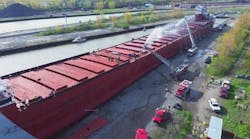What type of construction? You may be surprised.
An important feature of a pre-incident plan is the classification of building construction. Classifying the type of building should be simple, quick and strategically relevant. The classification of a building should capture important strategic information including a snapshot of characteristics that are germane to each type of construction.
This article will provide the reader with a simple method for quickly identifying and strategically classifying each of the five basic types of building construction:
Type 1 — Fire Resistive
Type II — Non-Combustible
Type III — Ordinary
Type IV — Heavy Timber
Type V — Wood Frame
Command-O-Quiz
You are standing outside the big-box warehouse store similar to the one shown in the photo above. In one hand you hold a pencil, in the other hand a pre-incident plan form. After entering the date, name of the business, address, contact information and hydrant locations, there is a box that asks: Type of Building Construction? In this blank box you would enter "Type _":
- I
- II
- III
- IV
- V
If you know building construction, you know that there are two possible answers — the big-box warehouse store is either Type II, Non-Combustible, or Type III, Ordinary. It is impossible to answer the Command-O-Quiz until you have stepped inside and viewed the roof.
Before diving into the strategic classification of building construction, let's first do a quick review of the five basic types of building construction according to National Fire Protection Association (NFPA) 220, Standard on Types of Building Construction (2006 edition).
NFPA 220 classifies the five basic types of building construction based on "…the combustibility and the fire resistance rating of a building's structural elements. Fire walls, nonbearing exterior walls, nonbearing interior partitions, fire barrier walls, shaft enclosures, and openings in walls, partitions, floors, and roofs are not related to the types of building construction and are regulated by other standards and codes, where appropriate."
The NFPA 220 system designates the five types of construction using Roman numerals (I, II, III, etc.) followed by three Arabic numbers (332, 211, etc.) that indicate the fire-resistance rating requirement for specific structural elements. Each number of the Arabic trio designates the following:
- First Arabic number — Exterior bearing walls
- Second Arabic number — Columns, beams, girders, trusses and arches that are supporting bearing walls, columns or loads from more than one floor
- Third Arabic number — Type of floor construction
Notice that Type II (Non-Combustible) and Type V ("unprotected combustible") each allow a building in your community with three zeros (000) of fire resistance. Fire officers and firefighters should understand (and factor) that there is not a single fire code or building code that specifically provides for firefighter safety and survival. The codes are designed to get people out of the building, to prevent the passage of fire and to prevent collapse of the building. Granted, there are code citations intended to assist the firefighting effort (standpipes, emergency elevator operation, etc.); however, and I repeat with emphasis: There is not a single fire code or building code specifically intended to provide for firefighter safety and survival. That qualifies as an important size-up consideration.
Strategic Classification Of Building Construction
OK, enough with the code stuff. (I'm an operations guy, not a fire marshal.) Although it is important that you possess a fundamental understanding of how buildings are code classified, it is more important to classify buildings strategically during pre-incident planning and when executing a master craftsman size-up at 3 o'clock in the morning. Let's begin the transition to the strategic classification of building construction by linking the NFPA 220 classifications with what the Arabic numbers mean operationally:
Type I (442 or 332) — "Shall be those types in which the fire walls, structural elements, walls, arches, floors, and roofs are of approved noncombustible or limited-combustible materials."
Author comments: This type of construction is referred to as "Fire Resistive." The three-digit numbers refer to hours of fire resistance. The first number of the three-digit series refers to exterior bearing walls; the second number refers to columns, beams, girders, trusses and arches, supporting bearing walls, columns or loads from more than one floor; and the third number refers to floor construction. For example, in a 442 building, columns that support more than one floor must be protected with four hours of fire resistance and the floor assembly with two hours of fire resistance. Of strategic significance is the fact that non-load-bearing walls within a Type I (442) building are not required to have any degree of fire resistance.
- Type II (222, 111 or 000) — Author comments: The same NFPA 220 description as Type I (above), but as you can see the fire resistance requirements (222, 111 or 000) are less rigorous. This means that unprotected structural components can fail when exposed to high temperatures during a contents fire.
Type III (211 or 200) — "Shall be that type in which exterior walls and structural elements that are portions of exterior walls are of approved noncombustible or limited-combustible materials, and in which fire walls, interior structural elements, walls, arches, floors and roofs are entirely or partially of wood of smaller dimensions than required for Type IV construction or are of approved noncombustible, limited-combustible or other approved combustible materials."
Author comments: Keep things simple: Type III usually features a non-combustible exterior (walls) and a combustible interior (roof and floors).
Type IV (2HH) — "Shall be that type in which fire walls, exterior walls, and interior bearing walls and structural elements that are portions of such walls are of approved noncombustible or limited-combustible materials. Other interior structural elements, arches, floors and roofs shall be of solid or laminated wood without concealed spaces and shall comply with the allowable dimensions of 4.5.5."
Author comments: The letter H represents "heavy timber members." Examples: timber columns supporting a floor must be eight inches in their smallest dimension. However, timber columns supporting a roof are allowed to be somewhat smaller, six inches in their smallest dimension.
Type V (111 or 000) — "Shall be that type in which structural elements, walls, arches, floors, and roofs are entirely or partially of wood or other approved material."
Author comments: In other words, the entire load-bearing structural system can contribute fuel to the fire (burn).
MARK EMERY, EFO, is a shift battalion chief with the Woodinville, WA, Fire & Life Safety District. He is a graduate of the National Fire Academy's Executive Fire Officer program and an NFA instructor specialist. Emery received a bachelor of arts degree from California State University at Long Beach and is a partner with Fire Command Seattle LLC in King County, WA. He may be contacted at [email protected] or access his website www.competentcommand.com.
TYPES OF CONSTRUCTION
Strategic Classifications for Fire Officers
This is important! Listed in descending order of fire resistance, thus the out-of-sequence numbering. Remember, fire resistance equals time. For detailed descriptions of building construction classifications, refer to the NFPA Fire Protection Handbook, "NFPA 220, Standard on Types of Building Construction," or your local building code.
Mark Emery





